|
Term |
Definition |
ABC

Photo: Martin Posnette |
A class limited to any breed of dog except a collie or collie X. |
Agility course

Photo: Fiona Hulse |
Includes obstacles with contact areas/equipment in
addition to jumps tunnels, weaves. |
Angled Weaves
 |
Weaves that will pivot at base to
different angles, used as training aid. |
'A'Ramp/A-frame
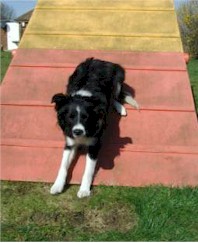 |
Two ramps 3ft wide hinged at the apex from the ground.
The last 3ft 6ins from the bottom of each ramp should be a contrasting colour to indicate
the area with which the dog should make contact. Each ramp to have a non-slip surface and
anti-slip slats at intervals, 6ins from contact. |
|
Banking |
When dog steps on or walks through wishing well, long
jump or water jump |
Baton
 |
Rod or stick usually wood or plastic exchanged between
competitors but remaining in the box in relay events, pairs or team. It is no longer
customary for a competitor to carry the baton when turning with their dog. |
Box
|
Area marked with poles at start/finish of course in
relay events where baton change may be required. |
|
Briefing |
Held immediately before the start of each class to
enable the judge to announce the course time, identify the start/finish points and any
special requirements for the course. In special classes any variation from standard marking
must be explained. |
Brush fence
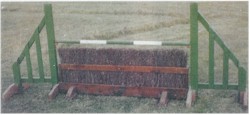 |
A hurdle with brush base constructed of twigs. Rarely
used in agility these days. |
Channel Weaves
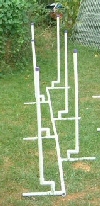 |
Two lines of weaves, leaving a
channel though which the dog runs and will close together, used to teach a dog to weave.
Weaves can have guide wires from pole to pole (to help keep dog in channel) |
Clear round
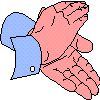 |
When dog and handler complete a course within the course
time without course faults. |
|
Collapsible tunnel
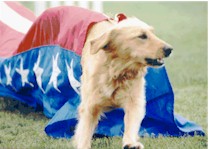
Photo: Tien Trans |
Circular of non-rigid material construction, with rigid
entrance. Also known as chute, cloth or soft tunnel. |
Contact points/areas
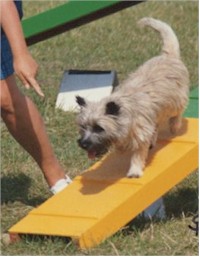
Photo: Kay Westgate |
Areas at the bases of the A frame, plank walk, cross
over, the ends of the seesaw, marked in contrasting colour, often yellow, which the dog
must touch when ascending and alighting from the obstacle, or incur penalty points.
|
Course
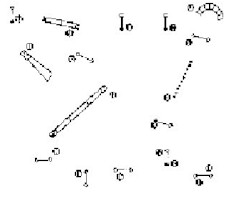 |
Numbered pattern of obstacles, minimum ten (10), maximum
twenty (20), designed by the judge for competition within the test area with designated
start and finish. |
|
Course fault |
Penalty incurred in units of five (5) when dog and
handler do not successfully negotiate obstacles e.g. handler touching dog or equipment, dog
knocking down pole, missing contact points/areas, refusal. |
|
Course time |
The time set by the judge in which the course must be
completed without incurring time faults, one fault for each second or part thereof by which
time is exceeded. |
Cross over
 |
Four planks approximately 12ft long. Width 10 ins
minimum 12ins maximum secured fixed to a metal table frame 4ft high with a top 2ft 8ins
square. The obstacle may be used with two or more planks but must be of stable
construction. The last 3ft from the bottom of each ramp should be a different colour to
indicate the area with which the dog should make contact. Each ramp to have a non-slip
surface, and anti-slip slats at intervals but not within 6ins of the start of a contact
area. |
Dogwalk
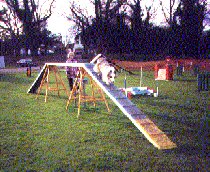 |
A plank approximately 4ft 6ins high with firmly fixed
ramps at either end with contact areas. The last 3ft from the bottom of each ramp should be
a different colour to indicate the area with which the dog should make contact. Each ramp
to have a non-slip surface, and anti-slip slats at intervals but not within 6ins of the
start of a contact area. |
|
Double handling |
When an individual other than the dog's own handler
attempts to assist the competing dog and handler, usually from outside the ring and which
must be penalised by the judge. |
Electronic timing
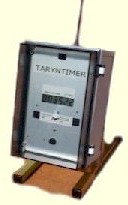 |
When dog's time is recorded by electronic equipment, the
dog breaking beams at start and finish of the course.
Photo: Martin Pollard |
Elimination
 |
When dog and handler are no longer eligible to continue
the course for competition, but at the judges discretion may complete the course or
continue for the duration of the course time. Elimination will follow three refusals/run
by, dog taking the wrong course, proceeding to the next obstacle before satisfactory
completion of the preceding obstacle, if the dog is out of control, runs out of the ring,
fouls the ring, is aggressive, handled or trained by the handler. |
Elimination and out
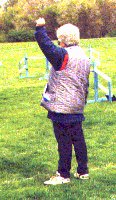 |
When dog and handler are required to leave the ring
immediately on elimination. This is at the judge's discretion and should be announced
during the briefing. |
|
Flick Flack
_ |
2/3 jumps in a parallel line (sometimes more) i.e. over
1, back over 2 and over 3. Also called a 'snake.'Diagram:
Andy Farrington |
|
Frame Tyre (See Hoop) |
Wooden or metal frame, surrounding
tyre or tyre hangs on open frame from ropes or chains. |
Hoop (Tyre)
 |
Hoop or Tyre mounted within a frame structure. Aperture
diameter 1ft 6in minimum. Aperture centre from the ground 3ft. The height of the hoop
should not be lowered. The frame and fixtures must be substantial or secured in such a way
that dogs cannot knock the obstacle over from either direction. Where tyres/hoops are
mounted within a frame structure the mechanism securing the tyre should be covered by a
suitable padding. Photo: Alan
Score |
Hurdle/Jump
 |
An easily displaceable pole 4ft minimum in length
resting on cups between two wings.
Photo: Action Shots |
Judge(s)
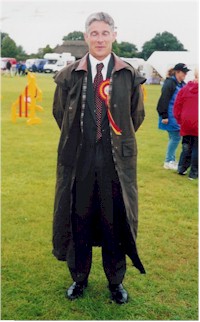 |
Official who designs the course, judges each dog and
handler in turn. indicating faults and penalties to scribe steward by signal or verbally. |
Jumping Course
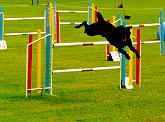 |
Includes jumps/hurdles, tunnels, weave, but not
obstacles with contact areas.
Photo: Alison Howe |
KC Registration
 |
Only dogs registered with the KC may compete at KC
licensed shows. There is a special working register for non-pedigree dogs. Only clubs
registered with the KC may organise and run a KC licensed Agility Test. |
|
Knock Down |
When dog dislodges pole from hurdle or brick from top of
wall. |
Lollipop Tyre
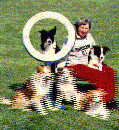 |
(See Hoop) |
Long Jump
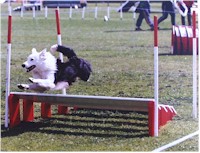
Photo: Alan Score |
Three to five (3-5) separate units comprise a long jump,
each unit a minimum length of 1.219m (4ft). The maximum overall length 1.524m (5ft). The
height of the front unit 127mm (5ins) and the height of the rear unit 38lmm (15ins). Marker
Poles with a minimum height of approximately 1.219m (4ft) are placed at the four corners.
|
|
Manual timing
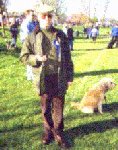 |
When dog's time is recorded manually by time keeper. |
Mini competition

Photo: Alan Score |
For mini dogs only who may not enter midi or standard
classes at the same event.
|
Mini dog
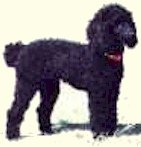 |
Dog measuring 15ins or below at the withers. |
Midi competition
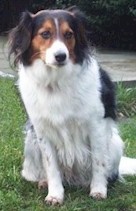 |
For midi dogs only who may not enter standard classes at
the same event. |
Midi dog
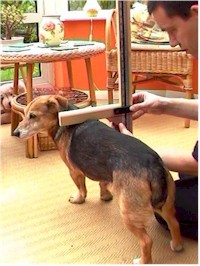
Photo: Peter van Dongen |
Dog measuring above 15ins and 17ins or below at the
withers. |
Missed contact
 |
When dog fails to touch any part of the contact area. |
NBC
 |
Nothing But Collies, a class limited to collies. |
|
NFC |
Not For Competition. Dogs not entered in a show must be listed on the entry
form as NFC. |
Paddling
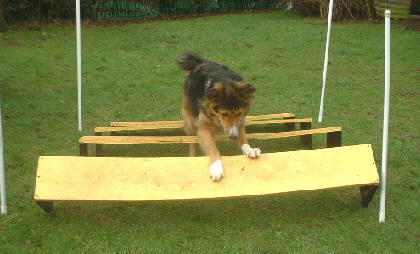
Photo: Gina Graham |
See Banking. |
Pairs relay

|
Competition consisting of two consecutive runs by each
dog and handler which may be over the same or different courses, often with a baton change
between handlers. |
Pause Box

|
Area defined on the ground where dog may be required to
halt in the down position for a stipulated count, usually five seconds. |
Pipe tunnel
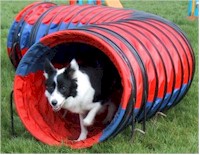
Photo: Andy Farrington |
This obstacle should have a diameter of a diameter of a
minimum of 2ft and should be a minimum of 10ft in length. Also known as rigid tunnel
|
|
Proof of posting
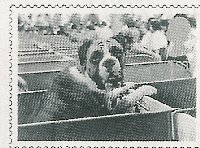 |
Record obtainable, free of charge, from Post Office
confirms postage of individual letters and is accepted by KC as evidence in cases where
show entries have been lost in the post. |
Pull Through
 |
When the dog is required to jump a Hurdle and then is
pulled through the gap between the Hurdle it just jumped and the Hurdle beside it. (See
Figure 1.) |
Refusal
 |
When a dog fails to attempt an obstacle. Three refusals
lead to elimination. |
|
Relay (pairs/team) |
When dog and handler run course consecutively, often
with baton change. |
Ring (test area)
 |
Marked area for competition measuring minimum 3 5 x 35
yards (or less at indoor venues), containing course of obstacles where dogs and handlers
are judged. |
Ring Caller/Steward
 |
Official/individual who ensures that competitors listed
for class are present and run in order. |
Ring number
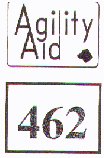 |
Number allocated to dog for entire show - usually based
on alphabetical order of owner's name, which must be displayed by handler when competing. |
Rising Spread Jump
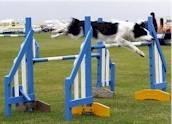
Photo: Alan Score |
A maximum of two single jumps as in hurdle placed
together to form a double spread. There must be no more than two elements to this obstacle.
|
Run
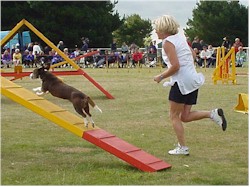 |
Competitive round undertaken by dog and handler. |
Running order
|
Numerical order in which dogs compete, arranged by
random draw for each class. |
Run out/by/under
 |
When a dog passes rather than attempts an obstacle,
incurring a refusal penalty. |
|
Schedule
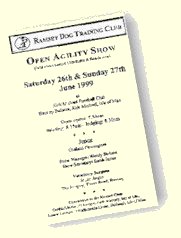 |
Printed notice of an Agility Test including standard
information required by KC e.g. host club, venue, entry fees, classification, awards
offered, judges and all other relevant information. |
Scribe Steward
|
The official responsible for recording faults as
indicated by the judge and times taken by time steward for each competitive round.
|
Scrimer
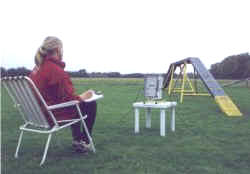
Photo: Martin Pollard |
The official responsible for recording faults as
indicated by the judge and times measured by the electronic timer for each competitive
round. Word coined by Anni Telford and Andy Farrington. |
|
Score Board Marker
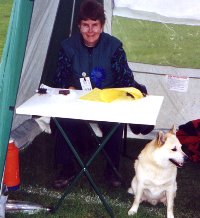 |
Records individual dog's scores and works out winning
places. |
See-Saw
 |
This obstacle consists of a plank, minimum length 12 ft,
maximum 14 ft, firmly mounted on a central bracket, maximum 2ft 3ins from the ground, with
a contact area at each end. The last 3ft from the bottom of each end should be a different
colour to indicate the area with which the dog should make contact. Each plank to have a
non-slip surface. It may have anti-slip slats at intervals but not within 6ins of the start
of a contact area.
Photo: Mary Ann Nester
|
Show Manager
 |
Officer of a KC registered society responsible for the
organisation and running of a show. |
Show Secretary
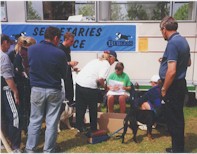 |
Officer of a KC registered society responsible for the
administration of show. |
|
Snake

|
Three jumps in a line. (See flick-flack.) |
Special classes
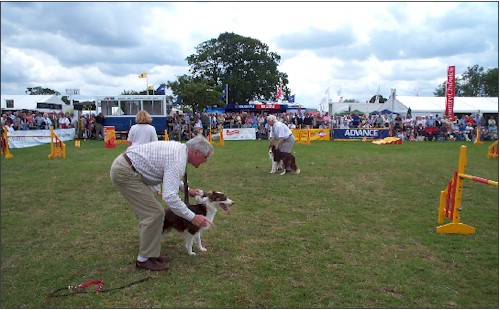 |
Distinct from standard classification with special
requirements as defined by the show society, which do not count towards progression in
standard classes. Including Gamblers, Helter Skelter, Time Fault & Out, Snooker, Mini Maxi
etc. |
|
Standard classification |
Classes of increasing difficulty (Elementary...
Advanced) in which eligibility is determined by number of wins by dog and handler/owner.
Open classes open to all. |
Standard marking
 |
Defined in KC agility regulations H(1)(B) five (5) which
must be adhered to in standard classes. |
Table
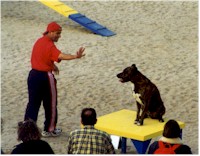 |
3ft sq. minimum. Height 2ft 6ins of stable construction
with a not-slip surface. |
Team Event
 |
Usually four separate dogs and handlers running
consecutively as a relay with total team time or with each dog timed separately. At Crufts
Dog Show one member from each team competes in each of four rounds. |
The BIG 'E'
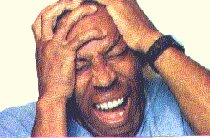 |
Elimination. |
|
Threadle |
Several pull-throughs sequenced in a straight line. |
Time Faults
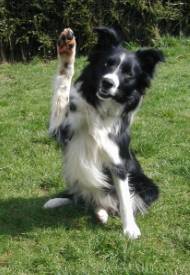 |
Penalties incurred in individual units corresponding to
the number of seconds or part thereof by which the dog's time exceeds the course time. |
|
Time Keeper (Timer) |
Official responsible for taking and recording the time
taken by each dog to complete a course, which may be by manual or more likely now,
electronic method. |
To fly the seesaw
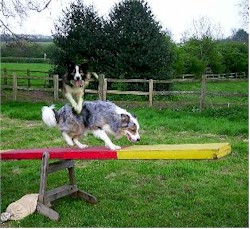 |
When a dog alights from the see saw before it has
touched the ground.
Photo: Alan Mitchell |
Touch mark
 |
See contact points. |
Tyre
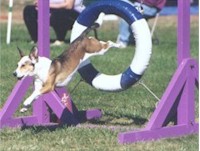 |
See Hoop. |
Wall
 |
A jump of wall-like construction with displaceable units
on top. |
Water Jump
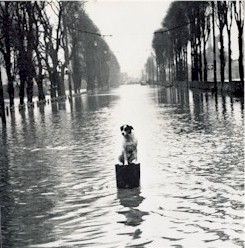 |
The overall spread shall not exceed 5ft with a minimum
width of 3ft. A low hurdle or brush, with a maximum height of 2ft may be placed in front of
the water. Marker poles, minimum height 4ft, placed on all four corners. |
|
Weaving poles
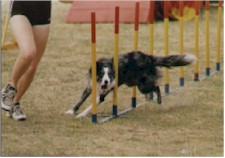 |
The minimum number of poles should be five and the
maximum number 12. The poles must be of rigid construction and with a minimum height of 2ft
6ins. The poles should be a minimum of 1ft 6ins, maximum 2ft apart. |
|
Wishing Well or Lych Gate
 |
This obstacle will have a roof of which the bottom will
not be less than 1 ft from the ground. It will have a displaceable top bar the height of
which will be 2ft 6ins. The minimum width should be 2ft 6ins. |
Wrong entry

Photo: Gina Graham |
When a dog enters the, start of the weaving poles from
the wrong side or passes the second pole before entry. This counts as a refusal. |